Unilever's Strategic Human Resource Management: An Overview
VerifiedAdded on 2021/02/20
|15
|3830
|26
Report
AI Summary
This report provides a comprehensive analysis of strategic human resource management (SHRM) at Unilever. It begins with an introduction to SHRM and its importance in attracting, developing, and retaining employees to achieve organizational goals. The report then delves into Task 1, examining trends impacting HR strategies, such as continuous improvement, workforce diversity, productivity enhancement, globalization, and changing skill requirements. Task 2 explores internal and external factors influencing HR practices, including market trends, laws, available funding, and employee relations. The report also discusses HR issues in public, private, and third sectors, such as recruitment, retention, and discipline. Task 3 focuses on strategic HRM growth and development, covering performance management, e-recruitment, and performance appraisals. Finally, Task 3 examines how change management supports HR strategies, including the Lewin Three-Step Model, and provides a conclusion summarizing the key findings. The report uses Unilever as a case study to illustrate these concepts, offering insights into how the company navigates various challenges and opportunities in its SHRM approach.
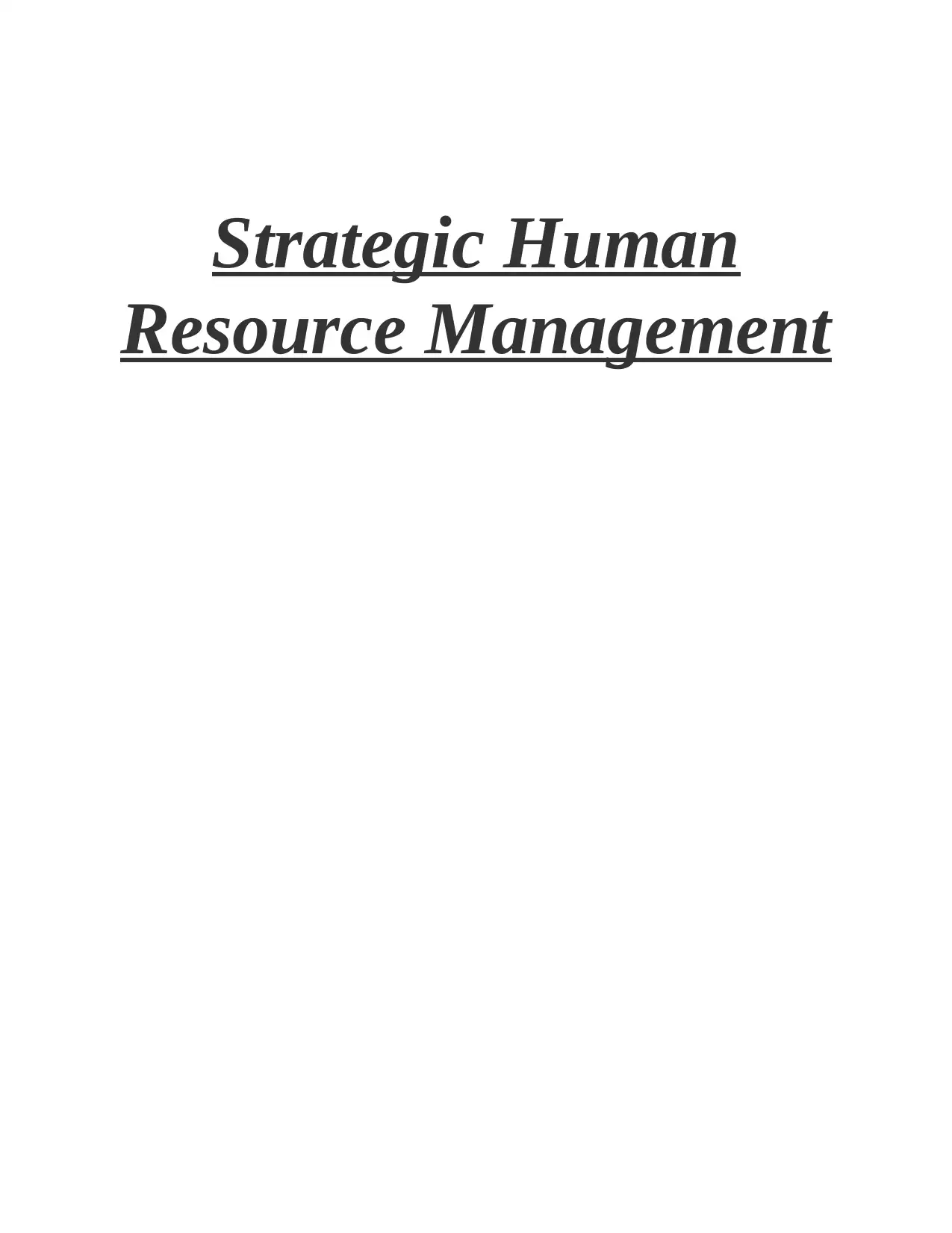
Strategic Human
Resource Management
Resource Management
Paraphrase This Document
Need a fresh take? Get an instant paraphrase of this document with our AI Paraphraser
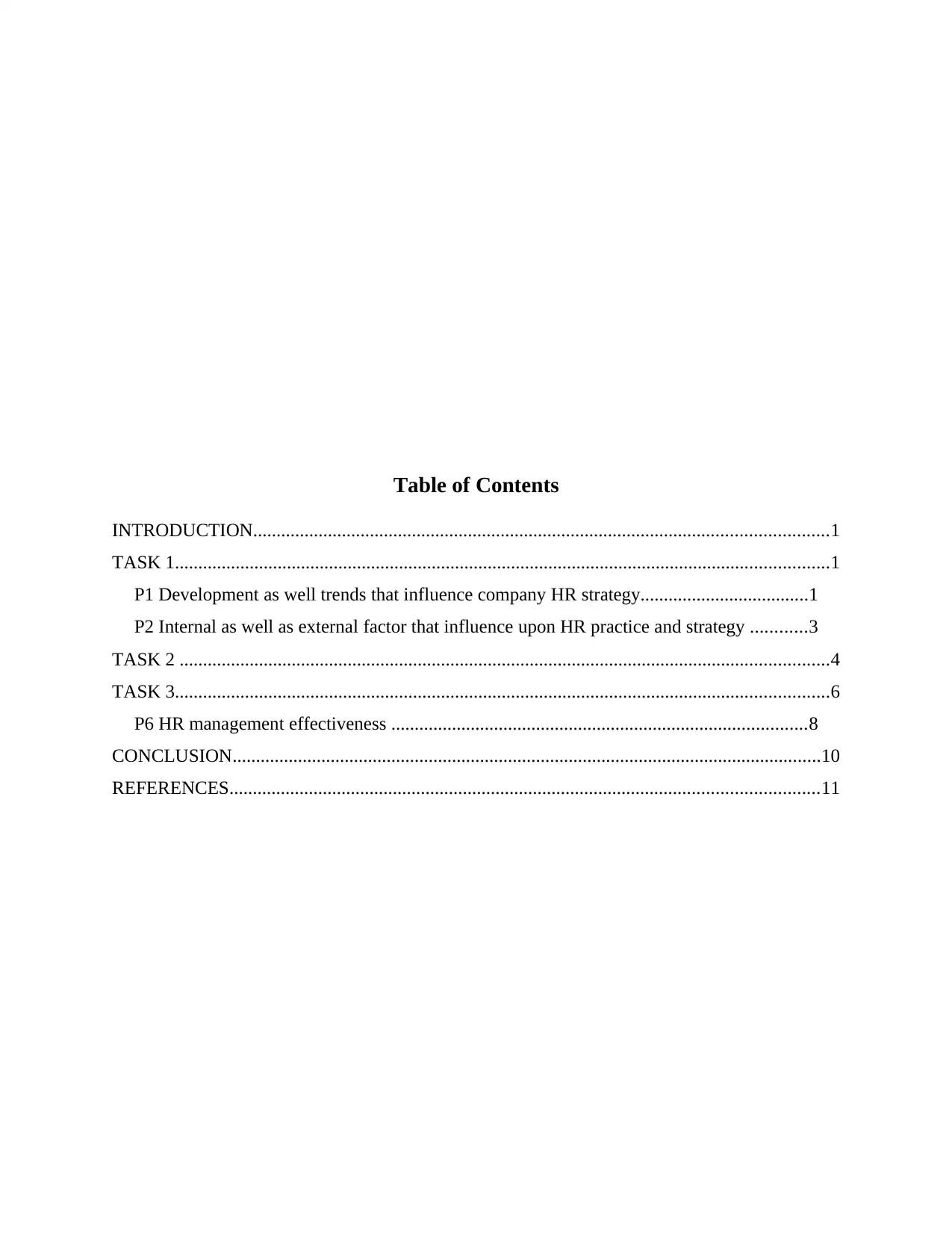
Table of Contents
INTRODUCTION...........................................................................................................................1
TASK 1............................................................................................................................................1
P1 Development as well trends that influence company HR strategy....................................1
P2 Internal as well as external factor that influence upon HR practice and strategy ............3
TASK 2 ...........................................................................................................................................4
TASK 3............................................................................................................................................6
P6 HR management effectiveness .........................................................................................8
CONCLUSION..............................................................................................................................10
REFERENCES..............................................................................................................................11
INTRODUCTION...........................................................................................................................1
TASK 1............................................................................................................................................1
P1 Development as well trends that influence company HR strategy....................................1
P2 Internal as well as external factor that influence upon HR practice and strategy ............3
TASK 2 ...........................................................................................................................................4
TASK 3............................................................................................................................................6
P6 HR management effectiveness .........................................................................................8
CONCLUSION..............................................................................................................................10
REFERENCES..............................................................................................................................11
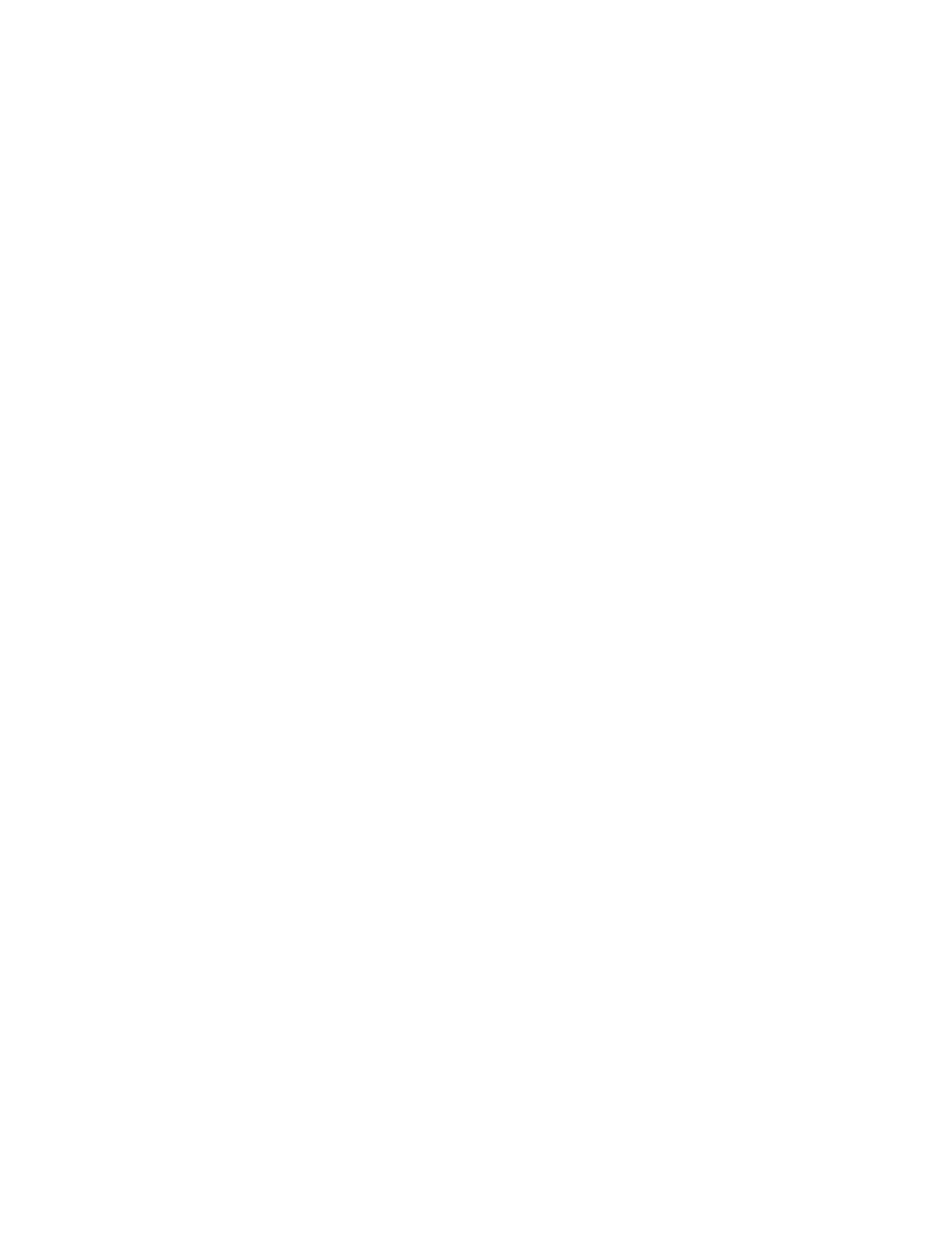
⊘ This is a preview!⊘
Do you want full access?
Subscribe today to unlock all pages.

Trusted by 1+ million students worldwide
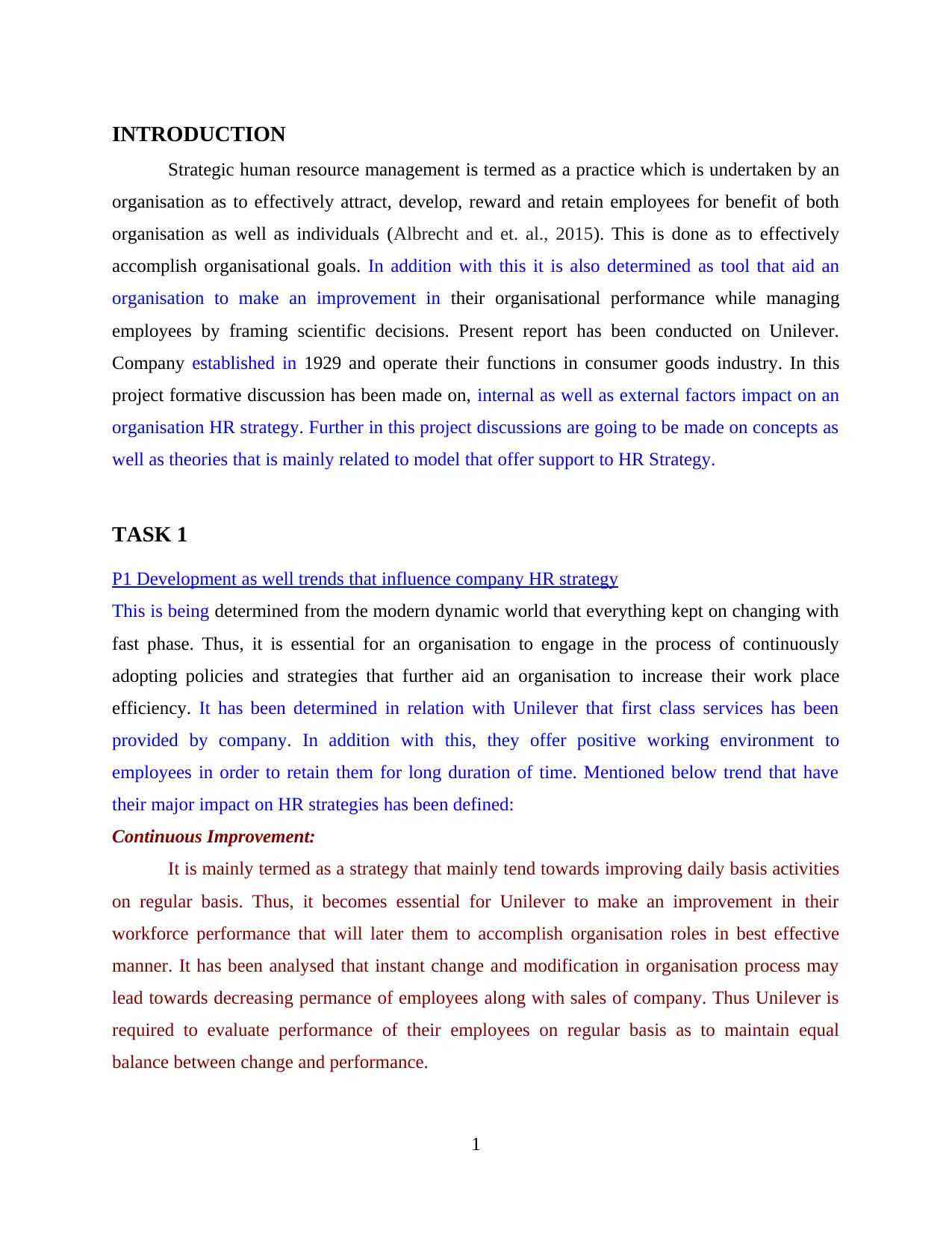
INTRODUCTION
Strategic human resource management is termed as a practice which is undertaken by an
organisation as to effectively attract, develop, reward and retain employees for benefit of both
organisation as well as individuals (Albrecht and et. al., 2015). This is done as to effectively
accomplish organisational goals. In addition with this it is also determined as tool that aid an
organisation to make an improvement in their organisational performance while managing
employees by framing scientific decisions. Present report has been conducted on Unilever.
Company established in 1929 and operate their functions in consumer goods industry. In this
project formative discussion has been made on, internal as well as external factors impact on an
organisation HR strategy. Further in this project discussions are going to be made on concepts as
well as theories that is mainly related to model that offer support to HR Strategy.
TASK 1
P1 Development as well trends that influence company HR strategy
This is being determined from the modern dynamic world that everything kept on changing with
fast phase. Thus, it is essential for an organisation to engage in the process of continuously
adopting policies and strategies that further aid an organisation to increase their work place
efficiency. It has been determined in relation with Unilever that first class services has been
provided by company. In addition with this, they offer positive working environment to
employees in order to retain them for long duration of time. Mentioned below trend that have
their major impact on HR strategies has been defined:
Continuous Improvement:
It is mainly termed as a strategy that mainly tend towards improving daily basis activities
on regular basis. Thus, it becomes essential for Unilever to make an improvement in their
workforce performance that will later them to accomplish organisation roles in best effective
manner. It has been analysed that instant change and modification in organisation process may
lead towards decreasing permance of employees along with sales of company. Thus Unilever is
required to evaluate performance of their employees on regular basis as to maintain equal
balance between change and performance.
1
Strategic human resource management is termed as a practice which is undertaken by an
organisation as to effectively attract, develop, reward and retain employees for benefit of both
organisation as well as individuals (Albrecht and et. al., 2015). This is done as to effectively
accomplish organisational goals. In addition with this it is also determined as tool that aid an
organisation to make an improvement in their organisational performance while managing
employees by framing scientific decisions. Present report has been conducted on Unilever.
Company established in 1929 and operate their functions in consumer goods industry. In this
project formative discussion has been made on, internal as well as external factors impact on an
organisation HR strategy. Further in this project discussions are going to be made on concepts as
well as theories that is mainly related to model that offer support to HR Strategy.
TASK 1
P1 Development as well trends that influence company HR strategy
This is being determined from the modern dynamic world that everything kept on changing with
fast phase. Thus, it is essential for an organisation to engage in the process of continuously
adopting policies and strategies that further aid an organisation to increase their work place
efficiency. It has been determined in relation with Unilever that first class services has been
provided by company. In addition with this, they offer positive working environment to
employees in order to retain them for long duration of time. Mentioned below trend that have
their major impact on HR strategies has been defined:
Continuous Improvement:
It is mainly termed as a strategy that mainly tend towards improving daily basis activities
on regular basis. Thus, it becomes essential for Unilever to make an improvement in their
workforce performance that will later them to accomplish organisation roles in best effective
manner. It has been analysed that instant change and modification in organisation process may
lead towards decreasing permance of employees along with sales of company. Thus Unilever is
required to evaluate performance of their employees on regular basis as to maintain equal
balance between change and performance.
1
Paraphrase This Document
Need a fresh take? Get an instant paraphrase of this document with our AI Paraphraser
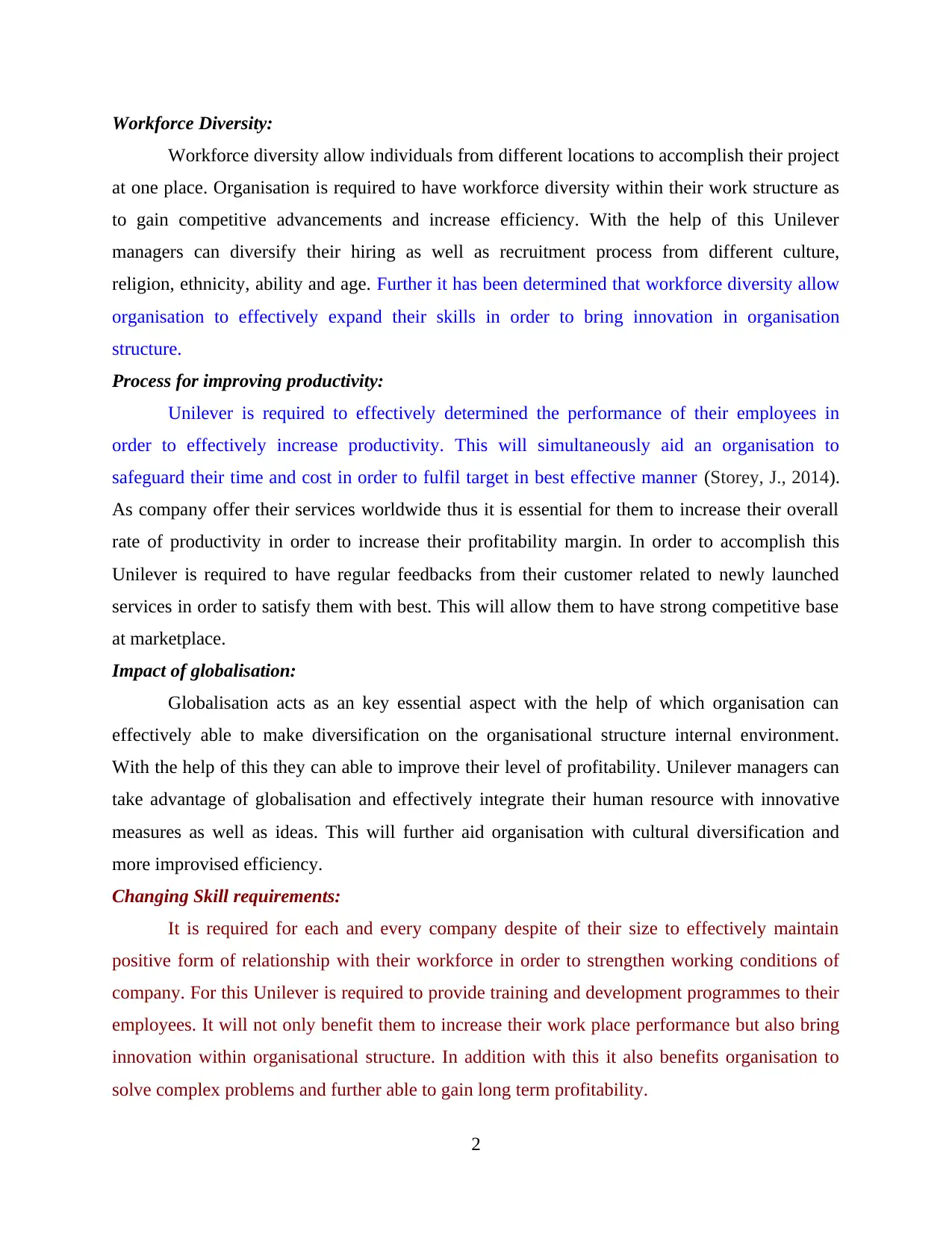
Workforce Diversity:
Workforce diversity allow individuals from different locations to accomplish their project
at one place. Organisation is required to have workforce diversity within their work structure as
to gain competitive advancements and increase efficiency. With the help of this Unilever
managers can diversify their hiring as well as recruitment process from different culture,
religion, ethnicity, ability and age. Further it has been determined that workforce diversity allow
organisation to effectively expand their skills in order to bring innovation in organisation
structure.
Process for improving productivity:
Unilever is required to effectively determined the performance of their employees in
order to effectively increase productivity. This will simultaneously aid an organisation to
safeguard their time and cost in order to fulfil target in best effective manner (Storey, J., 2014).
As company offer their services worldwide thus it is essential for them to increase their overall
rate of productivity in order to increase their profitability margin. In order to accomplish this
Unilever is required to have regular feedbacks from their customer related to newly launched
services in order to satisfy them with best. This will allow them to have strong competitive base
at marketplace.
Impact of globalisation:
Globalisation acts as an key essential aspect with the help of which organisation can
effectively able to make diversification on the organisational structure internal environment.
With the help of this they can able to improve their level of profitability. Unilever managers can
take advantage of globalisation and effectively integrate their human resource with innovative
measures as well as ideas. This will further aid organisation with cultural diversification and
more improvised efficiency.
Changing Skill requirements:
It is required for each and every company despite of their size to effectively maintain
positive form of relationship with their workforce in order to strengthen working conditions of
company. For this Unilever is required to provide training and development programmes to their
employees. It will not only benefit them to increase their work place performance but also bring
innovation within organisational structure. In addition with this it also benefits organisation to
solve complex problems and further able to gain long term profitability.
2
Workforce diversity allow individuals from different locations to accomplish their project
at one place. Organisation is required to have workforce diversity within their work structure as
to gain competitive advancements and increase efficiency. With the help of this Unilever
managers can diversify their hiring as well as recruitment process from different culture,
religion, ethnicity, ability and age. Further it has been determined that workforce diversity allow
organisation to effectively expand their skills in order to bring innovation in organisation
structure.
Process for improving productivity:
Unilever is required to effectively determined the performance of their employees in
order to effectively increase productivity. This will simultaneously aid an organisation to
safeguard their time and cost in order to fulfil target in best effective manner (Storey, J., 2014).
As company offer their services worldwide thus it is essential for them to increase their overall
rate of productivity in order to increase their profitability margin. In order to accomplish this
Unilever is required to have regular feedbacks from their customer related to newly launched
services in order to satisfy them with best. This will allow them to have strong competitive base
at marketplace.
Impact of globalisation:
Globalisation acts as an key essential aspect with the help of which organisation can
effectively able to make diversification on the organisational structure internal environment.
With the help of this they can able to improve their level of profitability. Unilever managers can
take advantage of globalisation and effectively integrate their human resource with innovative
measures as well as ideas. This will further aid organisation with cultural diversification and
more improvised efficiency.
Changing Skill requirements:
It is required for each and every company despite of their size to effectively maintain
positive form of relationship with their workforce in order to strengthen working conditions of
company. For this Unilever is required to provide training and development programmes to their
employees. It will not only benefit them to increase their work place performance but also bring
innovation within organisational structure. In addition with this it also benefits organisation to
solve complex problems and further able to gain long term profitability.
2
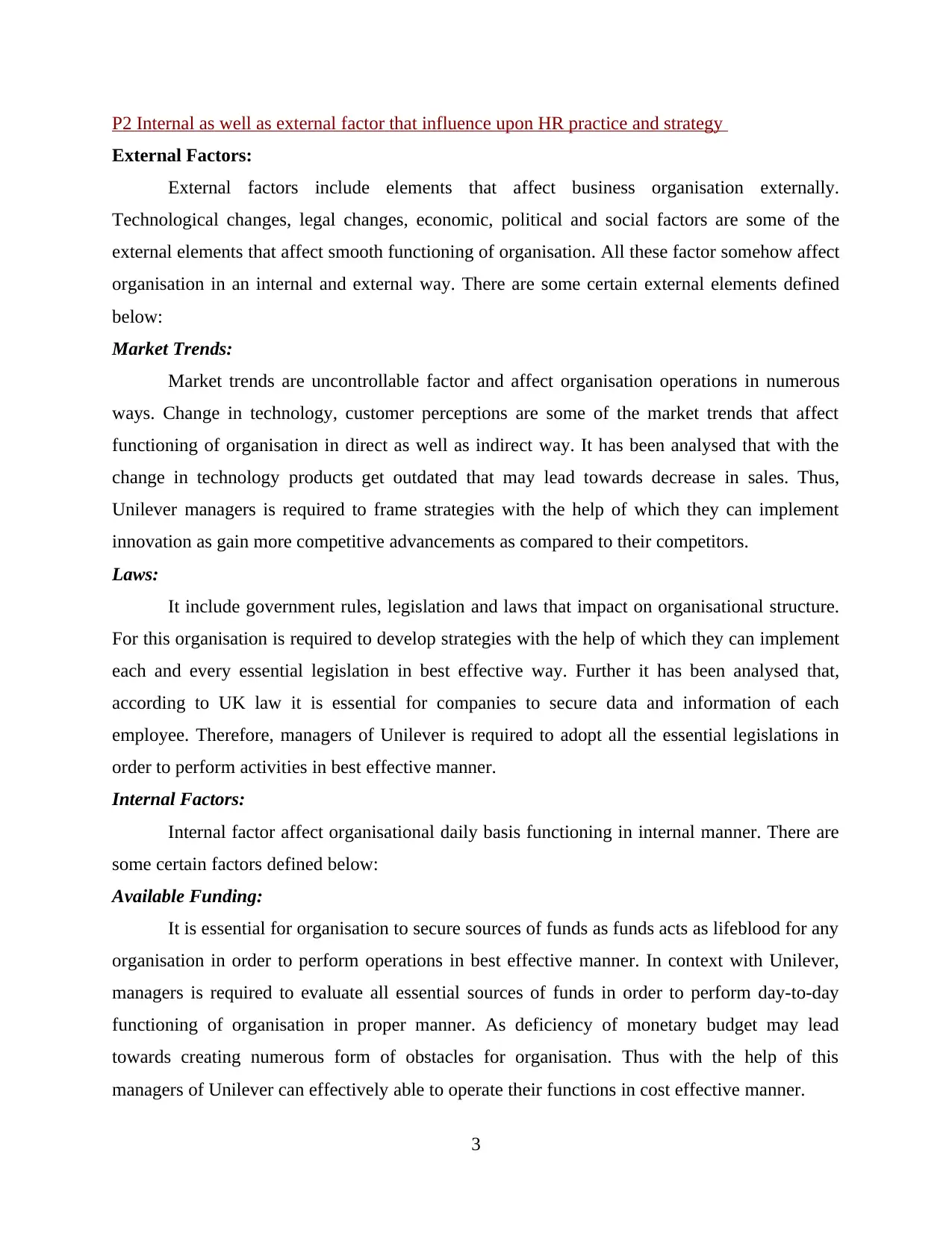
P2 Internal as well as external factor that influence upon HR practice and strategy
External Factors:
External factors include elements that affect business organisation externally.
Technological changes, legal changes, economic, political and social factors are some of the
external elements that affect smooth functioning of organisation. All these factor somehow affect
organisation in an internal and external way. There are some certain external elements defined
below:
Market Trends:
Market trends are uncontrollable factor and affect organisation operations in numerous
ways. Change in technology, customer perceptions are some of the market trends that affect
functioning of organisation in direct as well as indirect way. It has been analysed that with the
change in technology products get outdated that may lead towards decrease in sales. Thus,
Unilever managers is required to frame strategies with the help of which they can implement
innovation as gain more competitive advancements as compared to their competitors.
Laws:
It include government rules, legislation and laws that impact on organisational structure.
For this organisation is required to develop strategies with the help of which they can implement
each and every essential legislation in best effective way. Further it has been analysed that,
according to UK law it is essential for companies to secure data and information of each
employee. Therefore, managers of Unilever is required to adopt all the essential legislations in
order to perform activities in best effective manner.
Internal Factors:
Internal factor affect organisational daily basis functioning in internal manner. There are
some certain factors defined below:
Available Funding:
It is essential for organisation to secure sources of funds as funds acts as lifeblood for any
organisation in order to perform operations in best effective manner. In context with Unilever,
managers is required to evaluate all essential sources of funds in order to perform day-to-day
functioning of organisation in proper manner. As deficiency of monetary budget may lead
towards creating numerous form of obstacles for organisation. Thus with the help of this
managers of Unilever can effectively able to operate their functions in cost effective manner.
3
External Factors:
External factors include elements that affect business organisation externally.
Technological changes, legal changes, economic, political and social factors are some of the
external elements that affect smooth functioning of organisation. All these factor somehow affect
organisation in an internal and external way. There are some certain external elements defined
below:
Market Trends:
Market trends are uncontrollable factor and affect organisation operations in numerous
ways. Change in technology, customer perceptions are some of the market trends that affect
functioning of organisation in direct as well as indirect way. It has been analysed that with the
change in technology products get outdated that may lead towards decrease in sales. Thus,
Unilever managers is required to frame strategies with the help of which they can implement
innovation as gain more competitive advancements as compared to their competitors.
Laws:
It include government rules, legislation and laws that impact on organisational structure.
For this organisation is required to develop strategies with the help of which they can implement
each and every essential legislation in best effective way. Further it has been analysed that,
according to UK law it is essential for companies to secure data and information of each
employee. Therefore, managers of Unilever is required to adopt all the essential legislations in
order to perform activities in best effective manner.
Internal Factors:
Internal factor affect organisational daily basis functioning in internal manner. There are
some certain factors defined below:
Available Funding:
It is essential for organisation to secure sources of funds as funds acts as lifeblood for any
organisation in order to perform operations in best effective manner. In context with Unilever,
managers is required to evaluate all essential sources of funds in order to perform day-to-day
functioning of organisation in proper manner. As deficiency of monetary budget may lead
towards creating numerous form of obstacles for organisation. Thus with the help of this
managers of Unilever can effectively able to operate their functions in cost effective manner.
3
⊘ This is a preview!⊘
Do you want full access?
Subscribe today to unlock all pages.

Trusted by 1+ million students worldwide
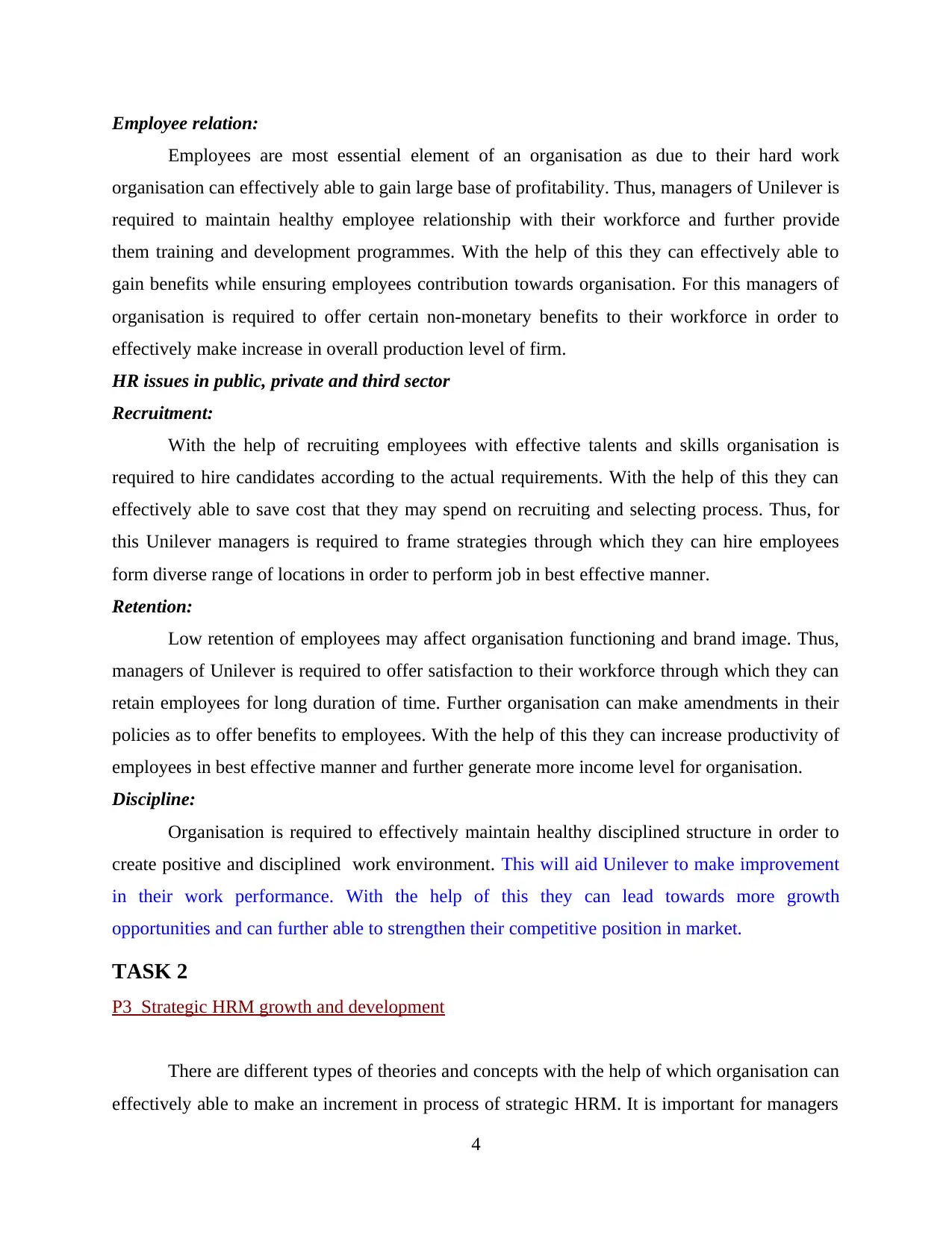
Employee relation:
Employees are most essential element of an organisation as due to their hard work
organisation can effectively able to gain large base of profitability. Thus, managers of Unilever is
required to maintain healthy employee relationship with their workforce and further provide
them training and development programmes. With the help of this they can effectively able to
gain benefits while ensuring employees contribution towards organisation. For this managers of
organisation is required to offer certain non-monetary benefits to their workforce in order to
effectively make increase in overall production level of firm.
HR issues in public, private and third sector
Recruitment:
With the help of recruiting employees with effective talents and skills organisation is
required to hire candidates according to the actual requirements. With the help of this they can
effectively able to save cost that they may spend on recruiting and selecting process. Thus, for
this Unilever managers is required to frame strategies through which they can hire employees
form diverse range of locations in order to perform job in best effective manner.
Retention:
Low retention of employees may affect organisation functioning and brand image. Thus,
managers of Unilever is required to offer satisfaction to their workforce through which they can
retain employees for long duration of time. Further organisation can make amendments in their
policies as to offer benefits to employees. With the help of this they can increase productivity of
employees in best effective manner and further generate more income level for organisation.
Discipline:
Organisation is required to effectively maintain healthy disciplined structure in order to
create positive and disciplined work environment. This will aid Unilever to make improvement
in their work performance. With the help of this they can lead towards more growth
opportunities and can further able to strengthen their competitive position in market.
TASK 2
P3 Strategic HRM growth and development
There are different types of theories and concepts with the help of which organisation can
effectively able to make an increment in process of strategic HRM. It is important for managers
4
Employees are most essential element of an organisation as due to their hard work
organisation can effectively able to gain large base of profitability. Thus, managers of Unilever is
required to maintain healthy employee relationship with their workforce and further provide
them training and development programmes. With the help of this they can effectively able to
gain benefits while ensuring employees contribution towards organisation. For this managers of
organisation is required to offer certain non-monetary benefits to their workforce in order to
effectively make increase in overall production level of firm.
HR issues in public, private and third sector
Recruitment:
With the help of recruiting employees with effective talents and skills organisation is
required to hire candidates according to the actual requirements. With the help of this they can
effectively able to save cost that they may spend on recruiting and selecting process. Thus, for
this Unilever managers is required to frame strategies through which they can hire employees
form diverse range of locations in order to perform job in best effective manner.
Retention:
Low retention of employees may affect organisation functioning and brand image. Thus,
managers of Unilever is required to offer satisfaction to their workforce through which they can
retain employees for long duration of time. Further organisation can make amendments in their
policies as to offer benefits to employees. With the help of this they can increase productivity of
employees in best effective manner and further generate more income level for organisation.
Discipline:
Organisation is required to effectively maintain healthy disciplined structure in order to
create positive and disciplined work environment. This will aid Unilever to make improvement
in their work performance. With the help of this they can lead towards more growth
opportunities and can further able to strengthen their competitive position in market.
TASK 2
P3 Strategic HRM growth and development
There are different types of theories and concepts with the help of which organisation can
effectively able to make an increment in process of strategic HRM. It is important for managers
4
Paraphrase This Document
Need a fresh take? Get an instant paraphrase of this document with our AI Paraphraser
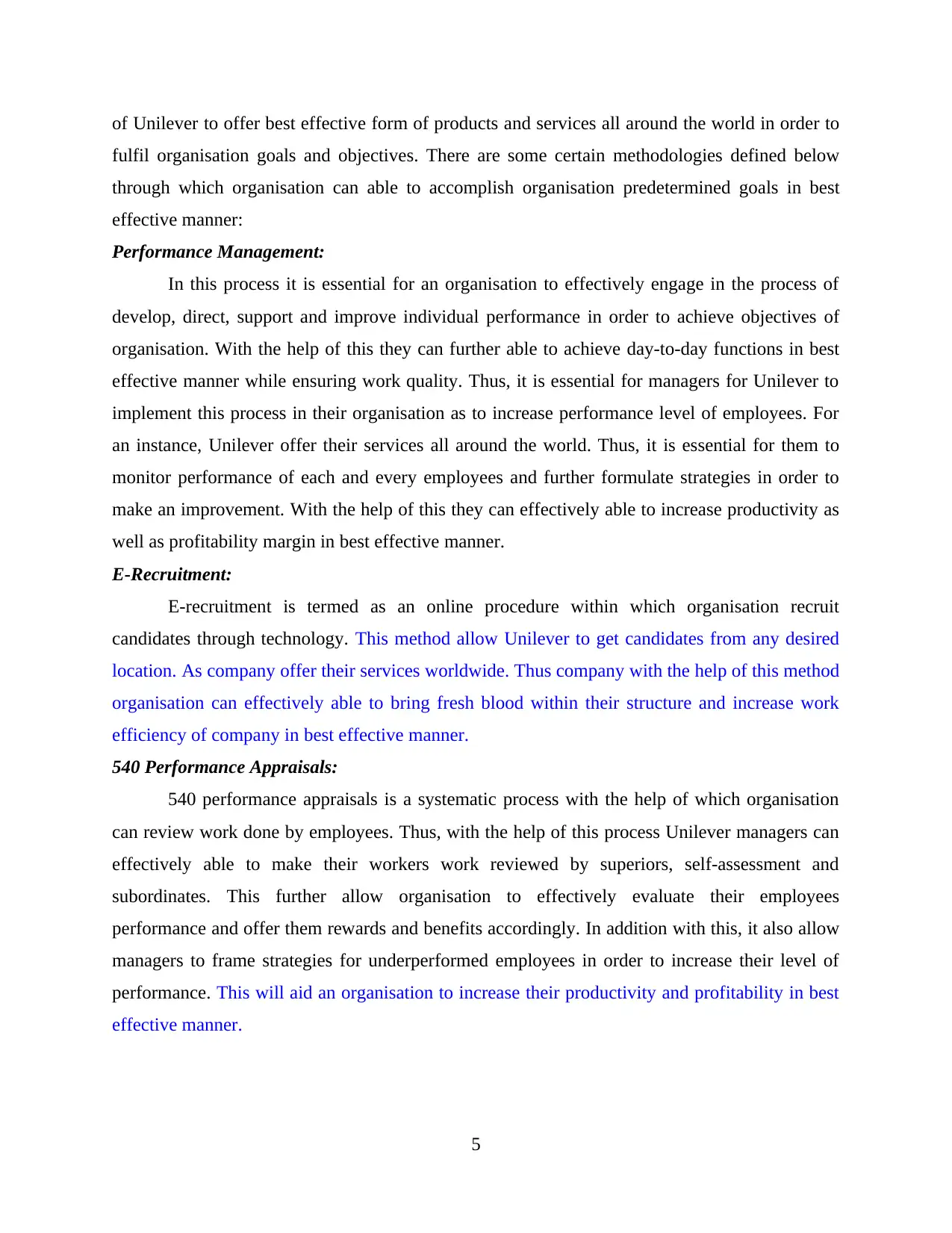
of Unilever to offer best effective form of products and services all around the world in order to
fulfil organisation goals and objectives. There are some certain methodologies defined below
through which organisation can able to accomplish organisation predetermined goals in best
effective manner:
Performance Management:
In this process it is essential for an organisation to effectively engage in the process of
develop, direct, support and improve individual performance in order to achieve objectives of
organisation. With the help of this they can further able to achieve day-to-day functions in best
effective manner while ensuring work quality. Thus, it is essential for managers for Unilever to
implement this process in their organisation as to increase performance level of employees. For
an instance, Unilever offer their services all around the world. Thus, it is essential for them to
monitor performance of each and every employees and further formulate strategies in order to
make an improvement. With the help of this they can effectively able to increase productivity as
well as profitability margin in best effective manner.
E-Recruitment:
E-recruitment is termed as an online procedure within which organisation recruit
candidates through technology. This method allow Unilever to get candidates from any desired
location. As company offer their services worldwide. Thus company with the help of this method
organisation can effectively able to bring fresh blood within their structure and increase work
efficiency of company in best effective manner.
540 Performance Appraisals:
540 performance appraisals is a systematic process with the help of which organisation
can review work done by employees. Thus, with the help of this process Unilever managers can
effectively able to make their workers work reviewed by superiors, self-assessment and
subordinates. This further allow organisation to effectively evaluate their employees
performance and offer them rewards and benefits accordingly. In addition with this, it also allow
managers to frame strategies for underperformed employees in order to increase their level of
performance. This will aid an organisation to increase their productivity and profitability in best
effective manner.
5
fulfil organisation goals and objectives. There are some certain methodologies defined below
through which organisation can able to accomplish organisation predetermined goals in best
effective manner:
Performance Management:
In this process it is essential for an organisation to effectively engage in the process of
develop, direct, support and improve individual performance in order to achieve objectives of
organisation. With the help of this they can further able to achieve day-to-day functions in best
effective manner while ensuring work quality. Thus, it is essential for managers for Unilever to
implement this process in their organisation as to increase performance level of employees. For
an instance, Unilever offer their services all around the world. Thus, it is essential for them to
monitor performance of each and every employees and further formulate strategies in order to
make an improvement. With the help of this they can effectively able to increase productivity as
well as profitability margin in best effective manner.
E-Recruitment:
E-recruitment is termed as an online procedure within which organisation recruit
candidates through technology. This method allow Unilever to get candidates from any desired
location. As company offer their services worldwide. Thus company with the help of this method
organisation can effectively able to bring fresh blood within their structure and increase work
efficiency of company in best effective manner.
540 Performance Appraisals:
540 performance appraisals is a systematic process with the help of which organisation
can review work done by employees. Thus, with the help of this process Unilever managers can
effectively able to make their workers work reviewed by superiors, self-assessment and
subordinates. This further allow organisation to effectively evaluate their employees
performance and offer them rewards and benefits accordingly. In addition with this, it also allow
managers to frame strategies for underperformed employees in order to increase their level of
performance. This will aid an organisation to increase their productivity and profitability in best
effective manner.
5
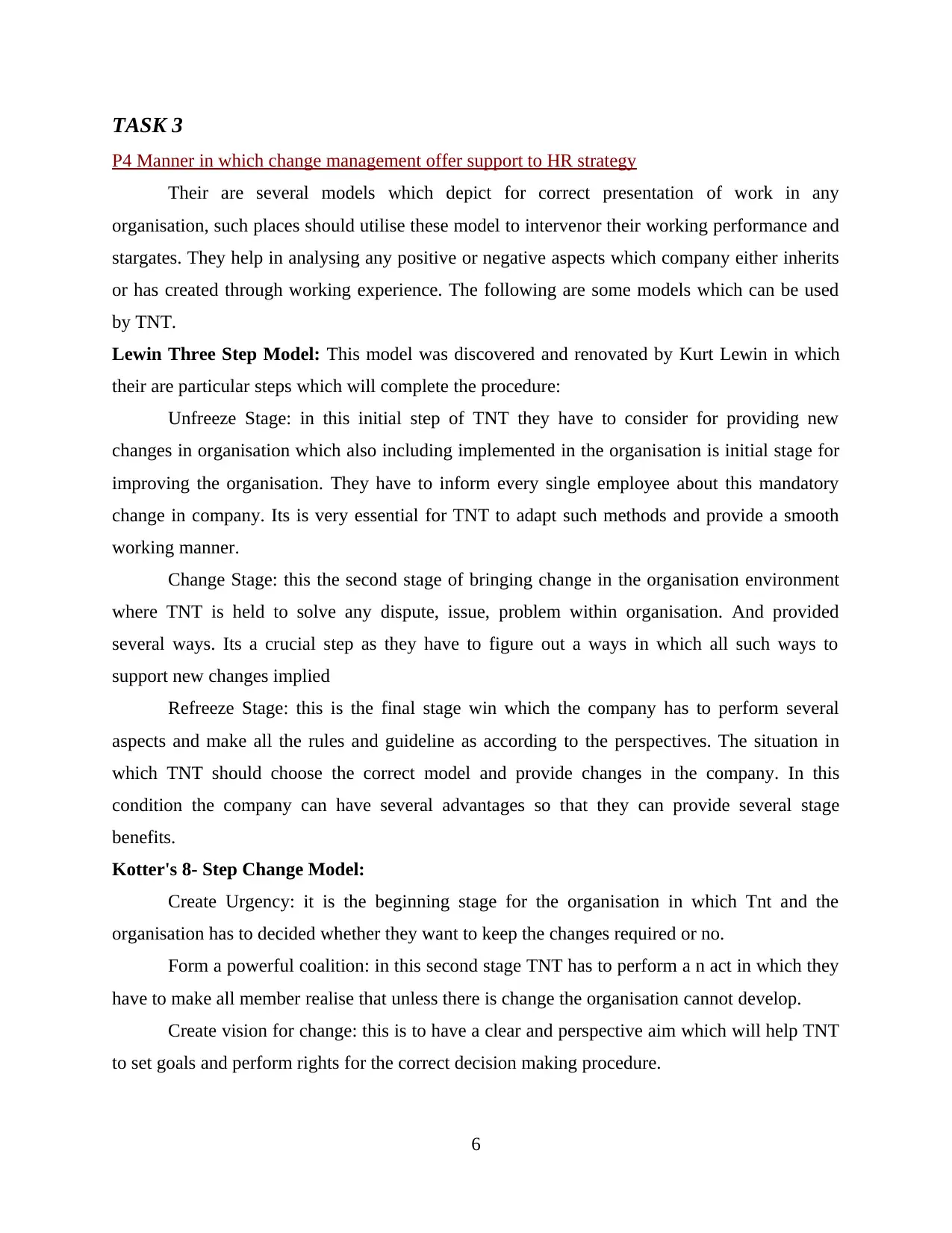
TASK 3
P4 Manner in which change management offer support to HR strategy
Their are several models which depict for correct presentation of work in any
organisation, such places should utilise these model to intervenor their working performance and
stargates. They help in analysing any positive or negative aspects which company either inherits
or has created through working experience. The following are some models which can be used
by TNT.
Lewin Three Step Model: This model was discovered and renovated by Kurt Lewin in which
their are particular steps which will complete the procedure:
Unfreeze Stage: in this initial step of TNT they have to consider for providing new
changes in organisation which also including implemented in the organisation is initial stage for
improving the organisation. They have to inform every single employee about this mandatory
change in company. Its is very essential for TNT to adapt such methods and provide a smooth
working manner.
Change Stage: this the second stage of bringing change in the organisation environment
where TNT is held to solve any dispute, issue, problem within organisation. And provided
several ways. Its a crucial step as they have to figure out a ways in which all such ways to
support new changes implied
Refreeze Stage: this is the final stage win which the company has to perform several
aspects and make all the rules and guideline as according to the perspectives. The situation in
which TNT should choose the correct model and provide changes in the company. In this
condition the company can have several advantages so that they can provide several stage
benefits.
Kotter's 8- Step Change Model:
Create Urgency: it is the beginning stage for the organisation in which Tnt and the
organisation has to decided whether they want to keep the changes required or no.
Form a powerful coalition: in this second stage TNT has to perform a n act in which they
have to make all member realise that unless there is change the organisation cannot develop.
Create vision for change: this is to have a clear and perspective aim which will help TNT
to set goals and perform rights for the correct decision making procedure.
6
P4 Manner in which change management offer support to HR strategy
Their are several models which depict for correct presentation of work in any
organisation, such places should utilise these model to intervenor their working performance and
stargates. They help in analysing any positive or negative aspects which company either inherits
or has created through working experience. The following are some models which can be used
by TNT.
Lewin Three Step Model: This model was discovered and renovated by Kurt Lewin in which
their are particular steps which will complete the procedure:
Unfreeze Stage: in this initial step of TNT they have to consider for providing new
changes in organisation which also including implemented in the organisation is initial stage for
improving the organisation. They have to inform every single employee about this mandatory
change in company. Its is very essential for TNT to adapt such methods and provide a smooth
working manner.
Change Stage: this the second stage of bringing change in the organisation environment
where TNT is held to solve any dispute, issue, problem within organisation. And provided
several ways. Its a crucial step as they have to figure out a ways in which all such ways to
support new changes implied
Refreeze Stage: this is the final stage win which the company has to perform several
aspects and make all the rules and guideline as according to the perspectives. The situation in
which TNT should choose the correct model and provide changes in the company. In this
condition the company can have several advantages so that they can provide several stage
benefits.
Kotter's 8- Step Change Model:
Create Urgency: it is the beginning stage for the organisation in which Tnt and the
organisation has to decided whether they want to keep the changes required or no.
Form a powerful coalition: in this second stage TNT has to perform a n act in which they
have to make all member realise that unless there is change the organisation cannot develop.
Create vision for change: this is to have a clear and perspective aim which will help TNT
to set goals and perform rights for the correct decision making procedure.
6
⊘ This is a preview!⊘
Do you want full access?
Subscribe today to unlock all pages.

Trusted by 1+ million students worldwide
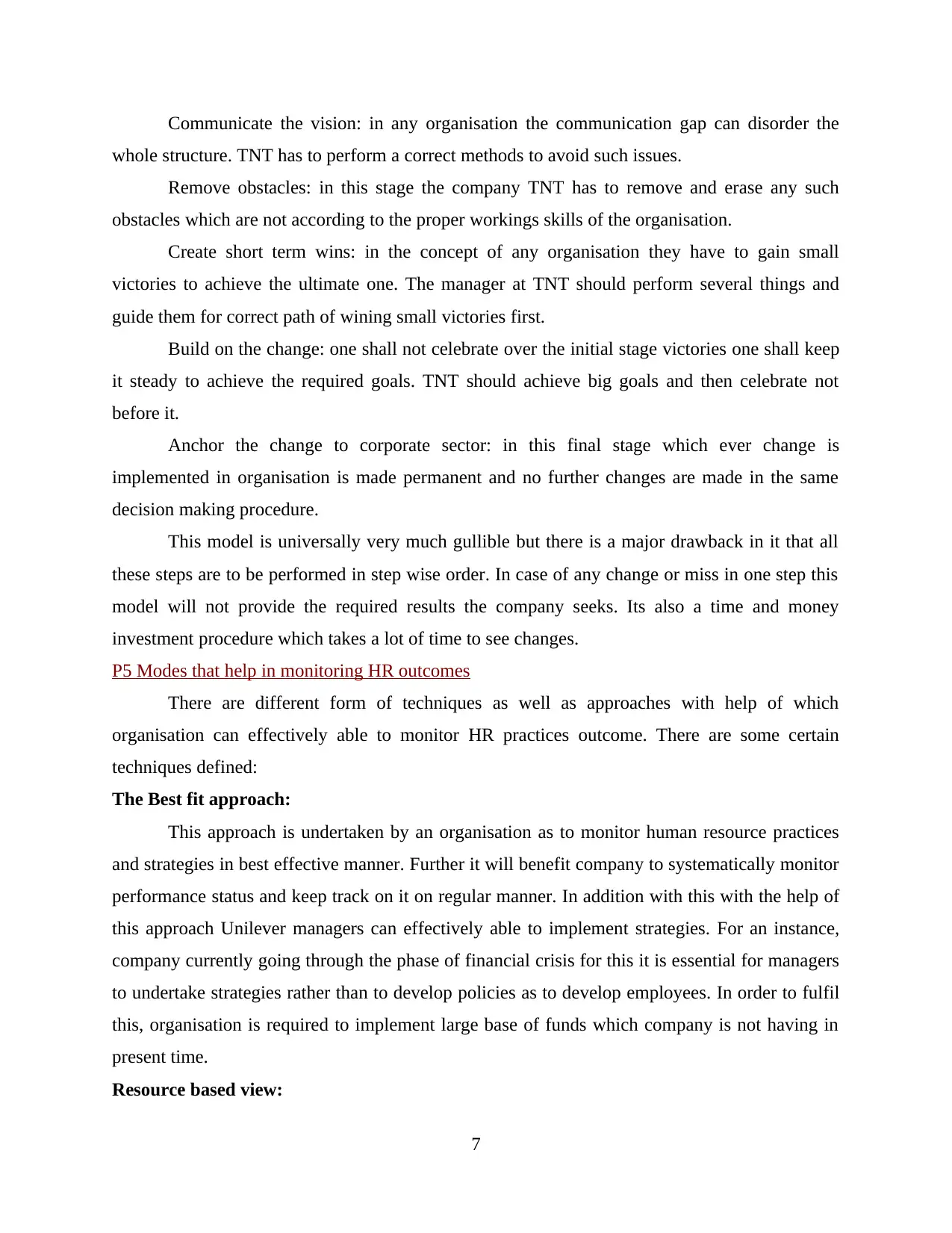
Communicate the vision: in any organisation the communication gap can disorder the
whole structure. TNT has to perform a correct methods to avoid such issues.
Remove obstacles: in this stage the company TNT has to remove and erase any such
obstacles which are not according to the proper workings skills of the organisation.
Create short term wins: in the concept of any organisation they have to gain small
victories to achieve the ultimate one. The manager at TNT should perform several things and
guide them for correct path of wining small victories first.
Build on the change: one shall not celebrate over the initial stage victories one shall keep
it steady to achieve the required goals. TNT should achieve big goals and then celebrate not
before it.
Anchor the change to corporate sector: in this final stage which ever change is
implemented in organisation is made permanent and no further changes are made in the same
decision making procedure.
This model is universally very much gullible but there is a major drawback in it that all
these steps are to be performed in step wise order. In case of any change or miss in one step this
model will not provide the required results the company seeks. Its also a time and money
investment procedure which takes a lot of time to see changes.
P5 Modes that help in monitoring HR outcomes
There are different form of techniques as well as approaches with help of which
organisation can effectively able to monitor HR practices outcome. There are some certain
techniques defined:
The Best fit approach:
This approach is undertaken by an organisation as to monitor human resource practices
and strategies in best effective manner. Further it will benefit company to systematically monitor
performance status and keep track on it on regular manner. In addition with this with the help of
this approach Unilever managers can effectively able to implement strategies. For an instance,
company currently going through the phase of financial crisis for this it is essential for managers
to undertake strategies rather than to develop policies as to develop employees. In order to fulfil
this, organisation is required to implement large base of funds which company is not having in
present time.
Resource based view:
7
whole structure. TNT has to perform a correct methods to avoid such issues.
Remove obstacles: in this stage the company TNT has to remove and erase any such
obstacles which are not according to the proper workings skills of the organisation.
Create short term wins: in the concept of any organisation they have to gain small
victories to achieve the ultimate one. The manager at TNT should perform several things and
guide them for correct path of wining small victories first.
Build on the change: one shall not celebrate over the initial stage victories one shall keep
it steady to achieve the required goals. TNT should achieve big goals and then celebrate not
before it.
Anchor the change to corporate sector: in this final stage which ever change is
implemented in organisation is made permanent and no further changes are made in the same
decision making procedure.
This model is universally very much gullible but there is a major drawback in it that all
these steps are to be performed in step wise order. In case of any change or miss in one step this
model will not provide the required results the company seeks. Its also a time and money
investment procedure which takes a lot of time to see changes.
P5 Modes that help in monitoring HR outcomes
There are different form of techniques as well as approaches with help of which
organisation can effectively able to monitor HR practices outcome. There are some certain
techniques defined:
The Best fit approach:
This approach is undertaken by an organisation as to monitor human resource practices
and strategies in best effective manner. Further it will benefit company to systematically monitor
performance status and keep track on it on regular manner. In addition with this with the help of
this approach Unilever managers can effectively able to implement strategies. For an instance,
company currently going through the phase of financial crisis for this it is essential for managers
to undertake strategies rather than to develop policies as to develop employees. In order to fulfil
this, organisation is required to implement large base of funds which company is not having in
present time.
Resource based view:
7
Paraphrase This Document
Need a fresh take? Get an instant paraphrase of this document with our AI Paraphraser
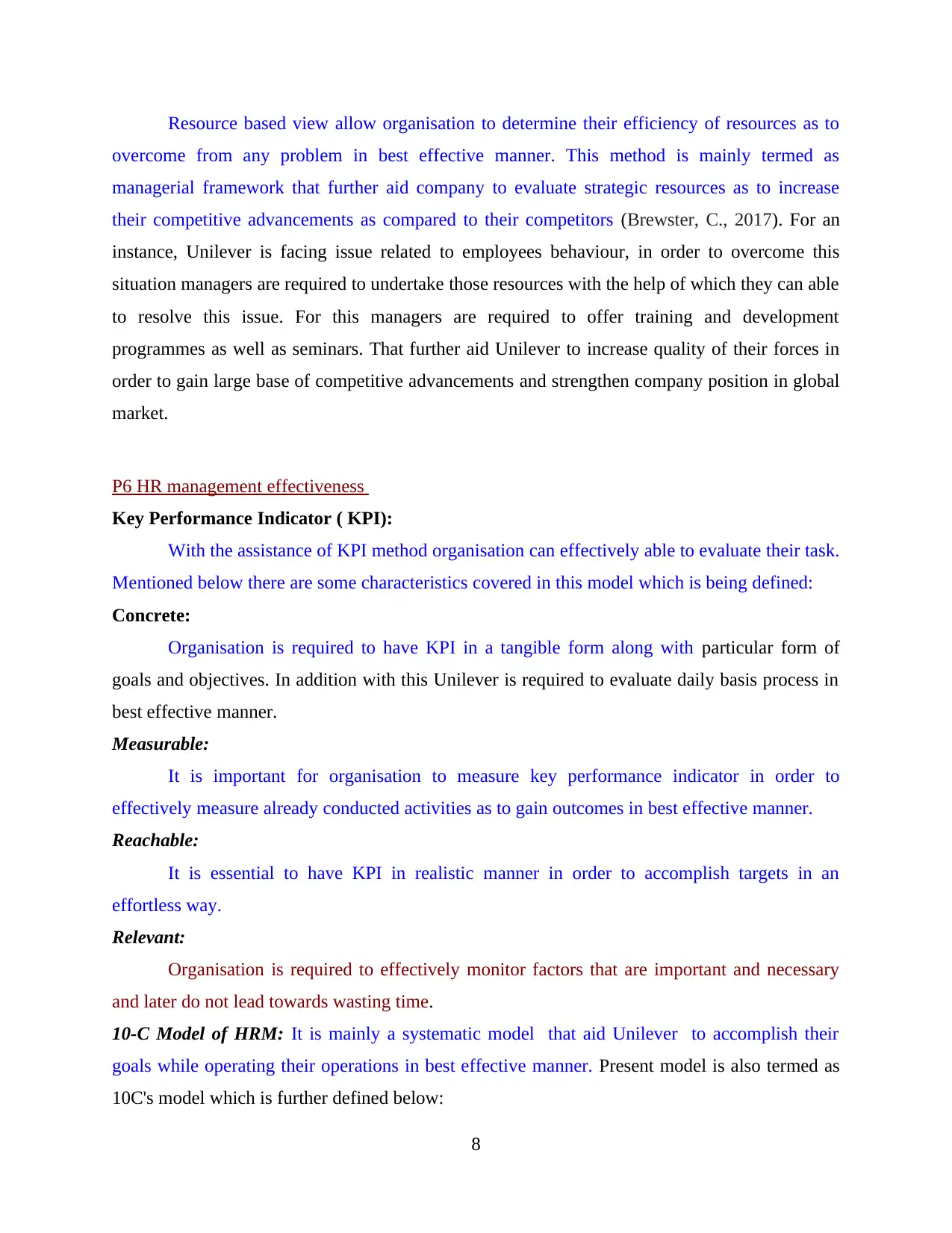
Resource based view allow organisation to determine their efficiency of resources as to
overcome from any problem in best effective manner. This method is mainly termed as
managerial framework that further aid company to evaluate strategic resources as to increase
their competitive advancements as compared to their competitors (Brewster, C., 2017). For an
instance, Unilever is facing issue related to employees behaviour, in order to overcome this
situation managers are required to undertake those resources with the help of which they can able
to resolve this issue. For this managers are required to offer training and development
programmes as well as seminars. That further aid Unilever to increase quality of their forces in
order to gain large base of competitive advancements and strengthen company position in global
market.
P6 HR management effectiveness
Key Performance Indicator ( KPI):
With the assistance of KPI method organisation can effectively able to evaluate their task.
Mentioned below there are some characteristics covered in this model which is being defined:
Concrete:
Organisation is required to have KPI in a tangible form along with particular form of
goals and objectives. In addition with this Unilever is required to evaluate daily basis process in
best effective manner.
Measurable:
It is important for organisation to measure key performance indicator in order to
effectively measure already conducted activities as to gain outcomes in best effective manner.
Reachable:
It is essential to have KPI in realistic manner in order to accomplish targets in an
effortless way.
Relevant:
Organisation is required to effectively monitor factors that are important and necessary
and later do not lead towards wasting time.
10-C Model of HRM: It is mainly a systematic model that aid Unilever to accomplish their
goals while operating their operations in best effective manner. Present model is also termed as
10C's model which is further defined below:
8
overcome from any problem in best effective manner. This method is mainly termed as
managerial framework that further aid company to evaluate strategic resources as to increase
their competitive advancements as compared to their competitors (Brewster, C., 2017). For an
instance, Unilever is facing issue related to employees behaviour, in order to overcome this
situation managers are required to undertake those resources with the help of which they can able
to resolve this issue. For this managers are required to offer training and development
programmes as well as seminars. That further aid Unilever to increase quality of their forces in
order to gain large base of competitive advancements and strengthen company position in global
market.
P6 HR management effectiveness
Key Performance Indicator ( KPI):
With the assistance of KPI method organisation can effectively able to evaluate their task.
Mentioned below there are some characteristics covered in this model which is being defined:
Concrete:
Organisation is required to have KPI in a tangible form along with particular form of
goals and objectives. In addition with this Unilever is required to evaluate daily basis process in
best effective manner.
Measurable:
It is important for organisation to measure key performance indicator in order to
effectively measure already conducted activities as to gain outcomes in best effective manner.
Reachable:
It is essential to have KPI in realistic manner in order to accomplish targets in an
effortless way.
Relevant:
Organisation is required to effectively monitor factors that are important and necessary
and later do not lead towards wasting time.
10-C Model of HRM: It is mainly a systematic model that aid Unilever to accomplish their
goals while operating their operations in best effective manner. Present model is also termed as
10C's model which is further defined below:
8
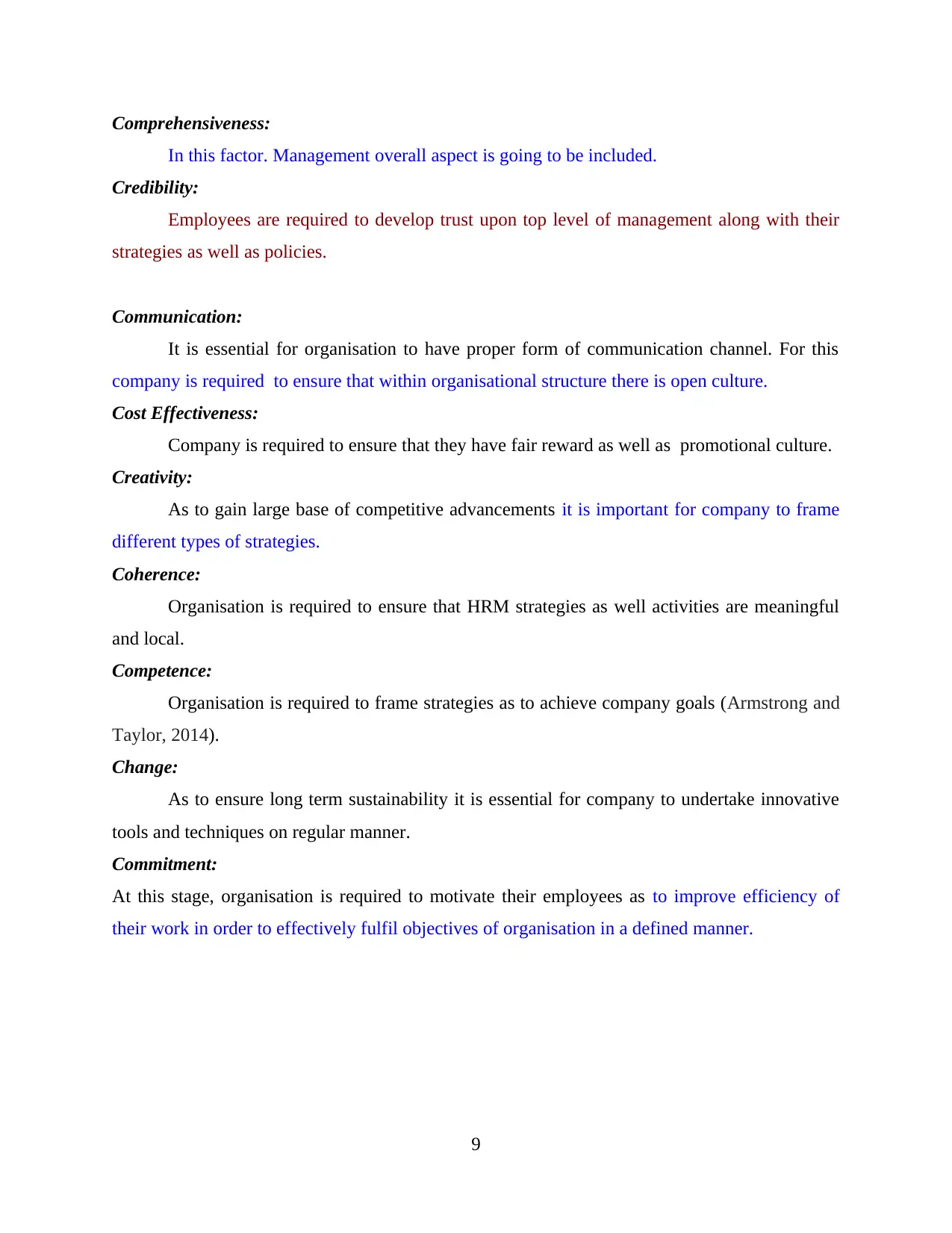
Comprehensiveness:
In this factor. Management overall aspect is going to be included.
Credibility:
Employees are required to develop trust upon top level of management along with their
strategies as well as policies.
Communication:
It is essential for organisation to have proper form of communication channel. For this
company is required to ensure that within organisational structure there is open culture.
Cost Effectiveness:
Company is required to ensure that they have fair reward as well as promotional culture.
Creativity:
As to gain large base of competitive advancements it is important for company to frame
different types of strategies.
Coherence:
Organisation is required to ensure that HRM strategies as well activities are meaningful
and local.
Competence:
Organisation is required to frame strategies as to achieve company goals (Armstrong and
Taylor, 2014).
Change:
As to ensure long term sustainability it is essential for company to undertake innovative
tools and techniques on regular manner.
Commitment:
At this stage, organisation is required to motivate their employees as to improve efficiency of
their work in order to effectively fulfil objectives of organisation in a defined manner.
9
In this factor. Management overall aspect is going to be included.
Credibility:
Employees are required to develop trust upon top level of management along with their
strategies as well as policies.
Communication:
It is essential for organisation to have proper form of communication channel. For this
company is required to ensure that within organisational structure there is open culture.
Cost Effectiveness:
Company is required to ensure that they have fair reward as well as promotional culture.
Creativity:
As to gain large base of competitive advancements it is important for company to frame
different types of strategies.
Coherence:
Organisation is required to ensure that HRM strategies as well activities are meaningful
and local.
Competence:
Organisation is required to frame strategies as to achieve company goals (Armstrong and
Taylor, 2014).
Change:
As to ensure long term sustainability it is essential for company to undertake innovative
tools and techniques on regular manner.
Commitment:
At this stage, organisation is required to motivate their employees as to improve efficiency of
their work in order to effectively fulfil objectives of organisation in a defined manner.
9
⊘ This is a preview!⊘
Do you want full access?
Subscribe today to unlock all pages.

Trusted by 1+ million students worldwide
1 out of 15
Related Documents
Your All-in-One AI-Powered Toolkit for Academic Success.
+13062052269
info@desklib.com
Available 24*7 on WhatsApp / Email
![[object Object]](/_next/static/media/star-bottom.7253800d.svg)
Unlock your academic potential
Copyright © 2020–2025 A2Z Services. All Rights Reserved. Developed and managed by ZUCOL.



